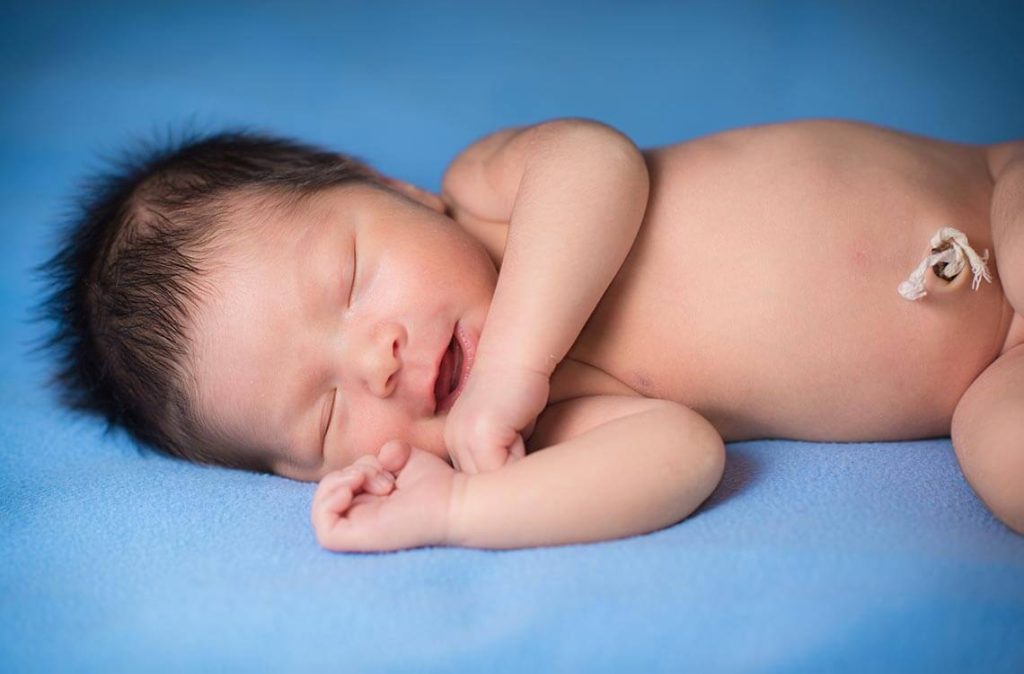Every baby has leftover umbilical cord after being born; a small little stump on what will soon by their belly button. The last remnant of their connection to their mother’s womb.
While often nothing to worry about, first-time parents may have some questions about how to care for it.
Well, no worries, because we will explain everything you need to know.
According to Dr Debra Palazzi, Medical Director of the Paediatrics Infectious Disease Clinic at Texas Children’s Hospital, the umbilical stump is the leftover piece of tissue from where your baby’s umbilical cord was cut during childbirth.
It will usually dry up and fall off on its own without any medical intervention.
What Happens to the Umbilical Stump
The fleshy bit of skin leftover from your baby’s umbilical cord (also called the umbilical stump) will usually dry up and fall off on it’s own without you needing to worry about it.
The typical metamorphosis of a stump begins with a change of colour. From yellowish-green to black or brown.
It may look weird or gross to you, but hey remember, you used to have one as a baby too.
Your baby’s umbilical stump should dry up and drop off 3 weeks after your baby is born, perhaps even sooner.
But if it stays on longer than that period, then it’s time to take them to the hospital or clinic for a paediatric consultation.
What to Do After the Stump Falls Off
If things go as planned, the stump will fall off, leaving behind a belly button.
But there may be a little of blood-tinged fluid when this happens, or a small raw spot.
Don’t worry, this is basically the same thing that happens when you peel off a scab.
The umbilical stump, for all intents and purposes is technically a scab.
However, if you notice more bleeding than normal and bleeding that never stops, it’s time to take them the hospital.
There’s also a small but rare chance that the stump may leave behind a scar tissue called a granuloma.
This blemish will leak a yellowish discharge that should clear up within a week.
Umbilical granuloma is a very treatable condition. So, you shouldn’t worry.
How to Care for Your Baby’s Umbilical Stump
- Basic hygiene: Stick to sponge baths don’t dunk underwater avoid using soap since this can irritate the baby’s skin. Opt for quick sponge baths instead. If there’s some dirty on the stump, dab at it gently with a wet, gentle toilet. Some parents use alcohol wipes but this isn’t recommended.
- Hands off: You should never try to remove or peel off the stump on your own. Even if it looks like it’s ready to fall off. Resist the urge to tug or rub either.
- Keep it dry: The key advice for stump care is to keep the area dry. This speeds up the healing process. So, quickly air out the stump after bathing your baby. Keep it exposed to air as often as you can.
- Dress and diaper delicately: Be very gentle when changing their diapers or clothes. And be sure to use ones that are loose and comfortable. Also change diapers regularly to reduce the chances of infection in the stump area. There are some diapers with an exposed part around the belly button for this exact purpose.
How to Spot An Infected Umbilical Stump
Though rare, some babies can get infected stumps, a condition known as omphalitis.
If you’re worried that you baby’s stump is infected here are some warning signs you should watch out for:
- Reddish, swollen skin around the stump
- A fluid-filled lump on or near the stump
- Pus or foul-smelling discharge
- Bleeding
- Fever
- Pain (baby cries when you touch their stump
The usual course of treatment is antibiotics, which should get them back up on their feet (figuratively speaking) in no time.
Belly Button Aftercare
As mentioned, you can expect a small bit of bleeding after the stump falls off.
However, if there’s a significant amount of blood, you should monitor the belly button closely.
If you notice any profuse bleeding, it’s time to take them to the doctor. Especially if the bleeding last longer than three days.
But otherwise, any leftover wound should clear up within a few days.
So, it’s best to let the belly button heal on its own. Less is more with umbilical stump aftercare.
Leave the Stump Alone
Sometimes the best course of action with umbilical stumps is to just leave it alone.
Avoid using ointments or oils to get it to fall of faster. Let nature take its course.
Some parents have even remarked that they didn’t even notice that their baby’s stump had fallen off.
But for those who do, they will usually save the cord stump as a souvenir, a common practice in many Asian families.
However, regardless what you decide to do with the stump, as long as your baby is healthy and okay after it falls off, then nothing else matters.
Disclaimer: The information provided in this article is for informational purposes only and should not be considered as medical advice from Motherhood. For any health-related concerns, it is advisable to consult with a qualified healthcare professional or medical practitioner.
For more insightful stories and fun recipes, stay tuned to Motherhood Story!
